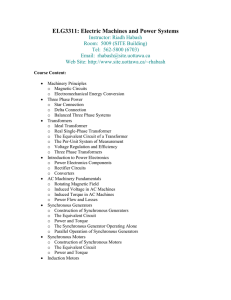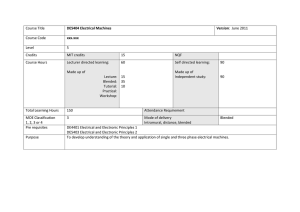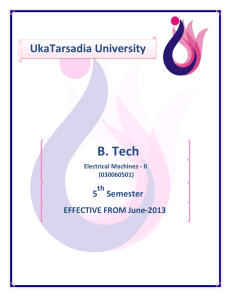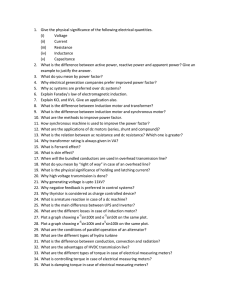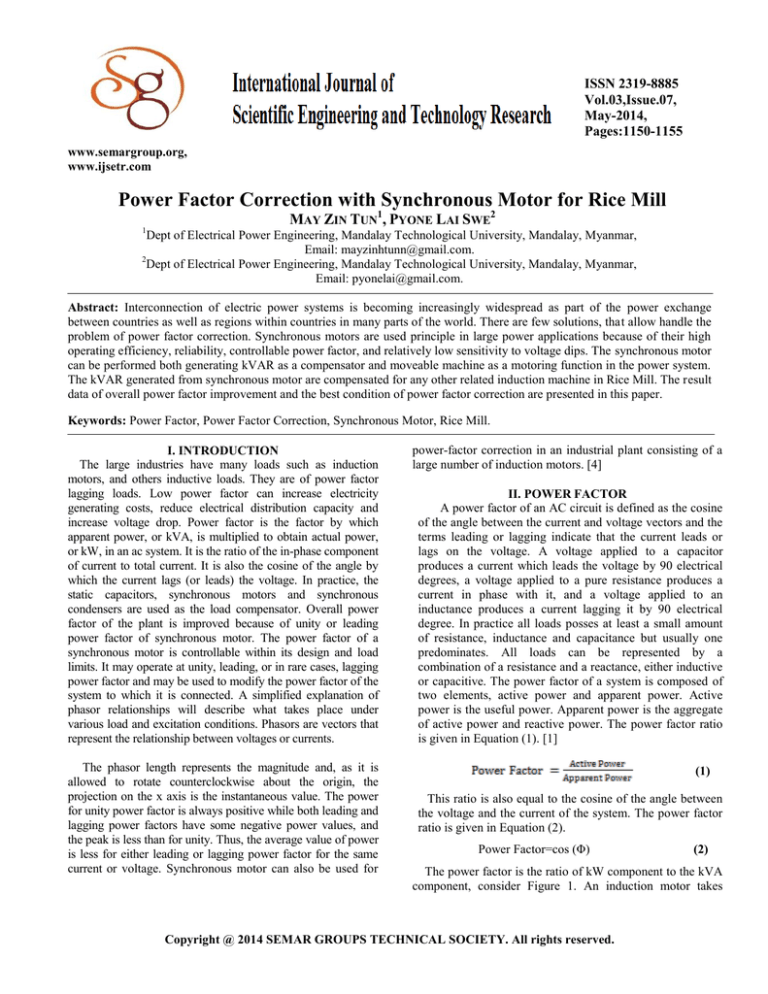
ISSN 2319-8885
Vol.03,Issue.07,
May-2014,
Pages:1150-1155
www.semargroup.org,
www.ijsetr.com
Power Factor Correction with Synchronous Motor for Rice Mill
MAY ZIN TUN1, PYONE LAI SWE2
1
Dept of Electrical Power Engineering, Mandalay Technological University, Mandalay, Myanmar,
Email: mayzinhtunn@gmail.com.
2
Dept of Electrical Power Engineering, Mandalay Technological University, Mandalay, Myanmar,
Email: pyonelai@gmail.com.
Abstract: Interconnection of electric power systems is becoming increasingly widespread as part of the power exchange
between countries as well as regions within countries in many parts of the world. There are few solutions, that allow handle the
problem of power factor correction. Synchronous motors are used principle in large power applications because of their high
operating efficiency, reliability, controllable power factor, and relatively low sensitivity to voltage dips. The synchronous motor
can be performed both generating kVAR as a compensator and moveable machine as a motoring function in the power system.
The kVAR generated from synchronous motor are compensated for any other related induction machine in Rice Mill. The result
data of overall power factor improvement and the best condition of power factor correction are presented in this paper.
Keywords: Power Factor, Power Factor Correction, Synchronous Motor, Rice Mill.
I. INTRODUCTION
The large industries have many loads such as induction
motors, and others inductive loads. They are of power factor
lagging loads. Low power factor can increase electricity
generating costs, reduce electrical distribution capacity and
increase voltage drop. Power factor is the factor by which
apparent power, or kVA, is multiplied to obtain actual power,
or kW, in an ac system. It is the ratio of the in-phase component
of current to total current. It is also the cosine of the angle by
which the current lags (or leads) the voltage. In practice, the
static capacitors, synchronous motors and synchronous
condensers are used as the load compensator. Overall power
factor of the plant is improved because of unity or leading
power factor of synchronous motor. The power factor of a
synchronous motor is controllable within its design and load
limits. It may operate at unity, leading, or in rare cases, lagging
power factor and may be used to modify the power factor of the
system to which it is connected. A simplified explanation of
phasor relationships will describe what takes place under
various load and excitation conditions. Phasors are vectors that
represent the relationship between voltages or currents.
The phasor length represents the magnitude and, as it is
allowed to rotate counterclockwise about the origin, the
projection on the x axis is the instantaneous value. The power
for unity power factor is always positive while both leading and
lagging power factors have some negative power values, and
the peak is less than for unity. Thus, the average value of power
is less for either leading or lagging power factor for the same
current or voltage. Synchronous motor can also be used for
power-factor correction in an industrial plant consisting of a
large number of induction motors. [4]
II. POWER FACTOR
A power factor of an AC circuit is defined as the cosine
of the angle between the current and voltage vectors and the
terms leading or lagging indicate that the current leads or
lags on the voltage. A voltage applied to a capacitor
produces a current which leads the voltage by 90 electrical
degrees, a voltage applied to a pure resistance produces a
current in phase with it, and a voltage applied to an
inductance produces a current lagging it by 90 electrical
degree. In practice all loads posses at least a small amount
of resistance, inductance and capacitance but usually one
predominates. All loads can be represented by a
combination of a resistance and a reactance, either inductive
or capacitive. The power factor of a system is composed of
two elements, active power and apparent power. Active
power is the useful power. Apparent power is the aggregate
of active power and reactive power. The power factor ratio
is given in Equation (1). [1]
(1)
This ratio is also equal to the cosine of the angle between
the voltage and the current of the system. The power factor
ratio is given in Equation (2).
Power Factor=cos (Φ)
(2)
The power factor is the ratio of kW component to the kVA
component, consider Figure 1. An induction motor takes
Copyright @ 2014 SEMAR GROUPS TECHNICAL SOCIETY. All rights reserved.
MAY ZIN TUN, PYONE LAI SWE
lagging current from the supply to produce flux in it
total. Accordingly, it is unnecessary to correct the power
magnetizing current even when supplying no shaft torque.
factor to exactly unity. The phasor diagram of single-phase
When the shaft torque is increased, both the amplitude of the
load of admittance is shown in Figure 2.
current and its power factor change. If the excitation is kept
constant, variation of the shaft torque causes the power factor
to vary. The variation in reactive kVAR with load depends on
the shape of the characteristics, that is, it depends on the
synchronous reactance. In general, the power factor of
industrial load is lagging and the effects of low lagging
power factors are considerable. The various items such as
transformer, transmission lines and machines posses
resistance and reactance and when the power factor of the
load is unity, the power factor of the generation will be
lagging. To obtain unity power factor on the generators, the
load would have to have a leading power factor.
Figure2. Phasor Diagram of Single-phase Load (Uncompensated)
[2].
Active Power P
Ap
par
ent
Po
we
rS
Reactive Power Q
Φ
The apparent power supplied to the loads is
SL
= V2GL- jV2BL
= PL+jQL
The power factor is expressed by the equation
cos L =
PL
SL
(3)
(4)
Where, PL=active power supplied to the load (kW)
QL=reactive power supplied to the load (kVAR)
SL=apparent power supplied to the load (kVA)
Figure1. Power Vector Diagram [1]
To supply a fixed amount of kW to a load, it is necessary
to provide a greater amount of kVA. The lower power
factor becomes in kVA implies increased losses in
generation, transmission and distribution and also requires
greater generation and distribution capacity. The various
items in a transmission and distribution system have some
resistance and this produces a loss when current flows. The
amount of loss is proportional to the square of current and
is associated with the kVA transmitted and not the kW
power. Maximum efficiency and utilization of generation
and distribution capacity would be obtained if the power
factor were increased to unity. However, it is not generally
possible to operate all the plant in an electrical supply
system at unity power factor. The various items such as
transformer, transmission lines and machines posses
resistance and reactance and when the power factor of the
load is unity, the power factor of the generation will be
lagging. To obtain unity power factor on the generators,
the load would have to have a leading power factor. [6]
Figure 3 shows the phasor relationships in which supply
current is in phase with V, making the overall power factor
unity. The supply current I S now has the smallest value
capable of supplying full power PL and the voltage V, and all
the reactive power required by the load is thus totally
compensated. Relieved of the reactive requirements of the
load, the supply now has excess capacity which is available
for supplying other loads.The apparent power exchanged
with the supply system is
Sγ=Pγ+ Qγ = VIγ*
=jV2BL
(5)
Most loads are inductive, requires capacitive compensation
for total compensation of reactive power, the reactive power
rating of the compensator is related to the rated power P L of
the load by
QL= PL tan L
(6)
III. POWER FACTOR CORRECTION
Power factor correction usually means the practice of
generating reactive power as close as possible to the load
which requires it, rather than supplying it from a remote
power station. The objective of power factor correction is
to reduce the current flowing in the circuit connecting the
consumer’s load with the source of supply. When the
power factor is high, the reactive component is a small
Figure3. Phasor Diagram of Single-phase Load (Compensated) [2].
percentage of the total and so a given change in the
reactive component produces only a small change in the
International Journal of Scientific Engineering and Technology Research
Volume.03, IssueNo.07, May-2014, Pages: 1150-1155
Power Factor Correction with Synchronous Motor for Rice Mill
The rated apparent power SL of the load is described
- Ia
by the equation
QL=S L sin L
(7)
SL 1 cos2L
Where, Sγ = apparent power of the compensator (kVA)
Qγ= reactive power of the compensator (kVAR)
Pγ= active power of the compensator (kW)
Power factor improvement can be obtained by adding
equipment designed solely to take leading kVAR, by
replacing equipment taking lagging kVAR and by
equipment operating at unity power factor or at a leading
power factor or installation new plant which would operate
at leading power factor. Power factor correcting equipment
may consist of static capacitor, synchronous condensers or
synchronous motor. All have advantages and disadvantages
and the choice of which to use in particular case may only
be described after considering: [6].
The amount of leading kVAR required
Electrical power changes
The variation of kVAR required
Method of control required
Type of load where power factor is improved
Any other power factor correcting plant installed
Future development of load
IV. PRINCIPLE OF SYNCHRONOUS MOTOR
A. Power Angle and Other Performance characteristic
on Synchronous Motor
The real and reactive power delivered by a synchronous
generator, or received by a synchronous motor, can be
expressed in terms of the terminal voltage Vt, the generated
voltage Ef, the synchronous impedance Zs, and the power
angle or torque angle δ. Referring to Figure 4, it is
convenient to adopt a convention that makes positive the
real power P and the reactive power Q delivered by an
overexcited generator. Accordingly, the generator action
corresponds to positive values of δ, whereas the motor
action corresponds to negative values of δ. With the
adopted notation it follows that P > 0 for generator
operation, whereas P < 0 for motor operation.
Ef
-I a
(iii)
(iv)
Figure 4: Four Possible Cases of operation of a Roundrotor Synchronous Machine with Negligible Armature
Resistance [3].
Overexcited generator (pf lagging),P>0,Q>0,δ>0
Under excited generator (pf leading),p>0,q<0,δ>0
Overexcited generator (pf leading),p<0,q>0,δ<0
Under excited generator (pf lagging),p<0,q<0,δ<0
Further, positive Q means delivering inductive VARs for
a generator action, or receiving inductive VARs for a motor
action; negative Q means delivering capacitive VARs for a
generator action, or receiving capacitive VARs for a motor
action. It can be observed from Figure 2 that the power factor
is lagging when P and Q have the same sign, and leading
when P and Q have opposite signs.
B. Synchronous Motor with Different Excitations
A synchronous motor is said to have normal excitation
when Ef = Vt. If field excitation is such that Ef < Vt, the
motor is said to be under-excited. In both these conditions, it
has a lagging power factor as shown in Figure 5.
Ef
Ef
ER
θ
α
Ef = V
θ
α
α
Ia
ER
j I aXs
(b)
Ia
θ
α
Ia
Vt
(ii)
ER
Ef
α
α
Vt
δ
Vt
Lagging pf
ER
Ef
α
Ef < V Ia
Vt
(a)
Ef
Vt
(i)
Ef j I aXs
Lagging pf
j I aXs
Vt
δ
j IaXs
Ia
Ia
t
δ
Ef
δ
Ia
Ef = V
Ef < V
Lagging pf
Lagging pf
θ
α
=0
(c)
(d)
Figure 5.Vector Diagrams for Various Power Factors.
International Journal of Scientific Engineering and Technology Research
Volume.03, IssueNo.07, May-2014, Pages: 1150-1155
Ia Vt
MAY ZIN TUN, PYONE LAI SWE
On the other hand, if DC field excitation is such that Ef >
Vt, then motor is said to be over-excited and draws a leading
current, as shown in Figure 5(a). There will be some value of
excitation for which armature current will be in phase with
Vt, so that power factor will become unity, as shown in
Figure 5(b). The value of α and hack e.m.f E f can be found
with the help of vector diagrams for various power factors,
shown in Figures 5 (c) and (d).
V. DESIGN AND CALCULATION OF POWER
FACTOR CORRECTION BY USING SYNCHRONOUS
MOTOR
The designed rice mill consists of twelve numbers of
induction motors is shown in figure 6. The twelve numbers of
induction motors are two numbers of induction motors used
for Huller, two numbers of induction motors for Fan Motor,
two numbers of induction motors for Chaff Separator, two
numbers of induction motors for Rice Huller, two numbers of
induction motors for Work Polisher, two numbers of
induction motors or White Rice Grader. The ratings of
induction motors are 24.45kW, 52kW, 30kW, 47.76kW,
60kW and 110kW. The existing real and reactive power
loadings of Rice Mill at full load are shown in figure 7.
So, the total real power loadings PT = 648.42 kW
Total reactive power loadings, QT =571.86kVAr
Total apparent power loadings, ST = 864.56 kVA
And the overall power factor of Rice Mill = PT/ST
= 0.75 lagging
VCB
Fan
Motor
Chaff
Separator
Rice
Huller
IM
IM
IM
IM
24.45kW,
0.75(lag)
52kW,
0.75(lag)
30kW,
0.75(lag)
Husker
Figure6.
Mill
Induction
47.76kW,
0.75(lag)
Motors
White Rice
Grader
Work
Polisher
IM
IM
p.f =
(10)
S=
(11)
The power factor of plant has in the designed power factor
limit. There are two methods to improve the design power
factor of plant .The two methods are
1. Addition of synchronous motors and
2. Reduction of induction motors
The characteristic features of the both solution are:
Designed condition one is established by using unity
power factor synchronous motor and induction motors.
Designed condition two is established by using 0.8
leading power factor synchronous motor and induction
motors.
TABLE I: PERCENTAGE OF INDUCTION MOTORS
LOADING
% of
Load
Reactive
Power(kVAR)
25
Real
Power
(kW)
162.1
50
324.2
285.9
75
486.3
428.9
100
648.4
571.8
142.9
TABLE II: RESULT OF CONDITION ONE (600KW,
PF UNITY) OF SYNCHRONOUS MOTOR
110kW,
0.75(lag)
60kW,
0.75(lag)
Loading
In this paper, the rating of synchronous motor to
compensate the reactive power of Rice Mill Factory is chosen
as 804hp. It is more cost and so that only chosen 600kW
(804hp) synchronous motor. This rating is to improve the
power factor 0.75 to 0.98lagging.Table I, II and III are detail
result data. Using the following Equations,
P = VIcosΦ
(8)
Q = P×tanΦ
(9)
in
Rice
220
Real Power
Reactive Power
Real Power(kW)& Reactive Power(kVAR)
200
180
160
140
120
100
80
60
40
1
2
3
4
Plants
5
6
When the loads of induction motor vary from 25 percent
to 125 percent; the power factor of overall plant also changes
from 0.99 to 0.91. This result is shown in Figure 8. From
Table II, when the loads of induction motor vary from 25% to
125%, the power factor of overall plant also change from
Figure7. Existing Real and Reactive Power Loadings of
Rice Mill.
International Journal of Scientific Engineering and Technology Research
Volume.03, IssueNo.07, May-2014, Pages: 1150-1155
Power Factor Correction with Synchronous Motor for Rice Mill
unity to 0.91 lagging power factor. This result is shown in
VI. CONCLUSION
Figure 9. In comparison of Table I and II, the power factor of
The feature of power factor correction makes the
overall plant from Table II is more improve than from Table I
synchronous motor as a most useful industrial machine. In
because of 0.8 leading power factor of synchronous motor.
this paper, according to compare test of load changes of
induction motors, the condition two is better than condition
TABLE III: RESULT OF CONDITION TWO
one. In condition one, the power factor of plant is improved
(600KW, PF0.8) OF SYNCHRONOUS MOTOR
by using 600 kW, unity power factor of synchronous motor.
In condition two, the power factor of design plant is
improved by using 600 kW, 0.8 leading power factor of
synchronous motor. Therefore, the synchronous motor at
0.8 leading power factor more improve than at unity power
factor. By increasing field excitation of synchronous motor,
the power factor is varied from unity to leading power
factor. Therefore, the power factor limits between 0.95 and
unity by increasing field excitation of synchronous motor.
VII. REFERENCES
[1]Jakub Kepka, Faculty of Electrical Engineering.
“Reactive Power Compensation”, Wroclaw University of
Technology.
1
pf
0.99
0.98
[2]Jihn, Reactive Power Control in Electric System,
Wiley & Sons Inc., T.J.E.MILLER,(1982).
Overall PowerFactor
0.97
0.96
[3]Kumar, K. Murugesh. “Introduction and Synchronous
Machines.” Vikas Publishing Company Ltd, (2000).
0.95
0.94
[4] Brosan, G.S., and Hayden, J. T. 1996.Advance
Electrical Power and Machine.
0.93
0.92
0.91
[5]Stevenson, JR.W.D. 1969. Element of Power System.
0.9
20
40
60
80
100
120
140
Percent Load ofInductionMotors
Figure8. Relation of Percent Loads of Induction
Motors and Overall Power Factor by using unity
Power Factor of Synchronous Motor.
1
[6]Anonymous: Introduction to Compensation System,
Nokian Capacitor Ltd., Finland, (2005).
pf
Overall Power Factor
0.98
0.96
0.94
0.92
0.9
20
30
40
50
60
70
80
90
100
110
120
130
Percent Loads of Induction Motor
Figure9. Relation of Percent Loads of Induction
Motors and Overall Power Factor by Using 0.8
Leading Power Factor of Synchronous Motor.
Therefore, the using of 0.8 leading power factor of
synchronous motor is best condition to improve the power
factor of the plant.
International Journal of Scientific Engineering and Technology Research
Volume.03, IssueNo.07, May-2014, Pages: 1150-1155



